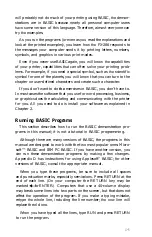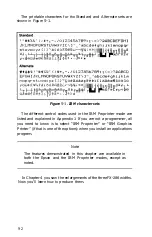
Computer-to-Printer Communications
A computer and printer communicate by means of numbered
codes. If you press the letter A on the keyboard, it is translated into a
numeric code, transmitted to a peripheral device (such as a video
screen or a printer) then converted back into the letter A.
To cope with the many different kinds of computer and printers
used today, a standard set of codes has been developed. This set of
codes is called the American Standard Code
for
Information Inter-
change, or ASCII
(pronounced ASK-KEY) for short. Almost all com-
puters use these ASCII codes to communicate with printers.
There are ASCII codes for all of the letters in the alphabet, both
upper- and lowercase, and for the numbers from 0 to 9. The ASCII
code also includes most punctuation marks, and some codes that con-
trol printer functions. If you refer to the ASCII chart in Appendix I,
you’ll find that all of these letters, numbers and punctuation marks
have been assigned code numbers from 32 through 255.
ASCII Codes
Although these codes are standard from computer to computer,
they can be expressed in a number of different ways. The chart in
Appendix I lists each ASCII code as a character (A, B, C, 1, 2, 3), as a
decimal and as a hexadecimal number. For example, the letter A is
represented as an A and as the decimal number 65. If you wanted to
print the letter A using the BASIC language, you would use the deci-
mal notation, written as CHR$(65).
The chart also shows the
hexadecimal
(or hex) value of each charac-
ter. The hexadecimal numbering system is based on units of 16; our
usual numbering system, decimal, is based on units of 10. In hex, the
letter A is expressed as 41H (the H stands for hexadecimal).
The ASCII codes are expressed in different ways to suit a variety of
applications. For example, the decimal notation is usually used in
BASIC programming, as illustrated earlier. However, some program-
mers prefer the hexadecimal system. Appendix I contains compara-
tive tables showing the ASCII characters, along with their decimal
and hexadecimal equivalents.
4-3
Summary of Contents for FX-286 - Impact Printer
Page 1: ......
Page 2: ......
Page 35: ......
Page 40: ...2 4 ...
Page 48: ...3 8 ...
Page 56: ...4 8 ...
Page 91: ...6 16 ...
Page 118: ...C 10 ...
Page 133: ...Epson Mode Commands G 5 ...
Page 134: ...G 6 ...
Page 166: ...H 4 ...
Page 173: ...International Character Width Table Roman characters Italic characters I 7 ...
Page 174: ...I 8 ...
Page 180: ...J 6 ...
Page 181: ...IBM Proprinter Mode Commands J 7 ...
Page 182: ...J 8 ...
Page 202: ...J 28 ...
Page 208: ...K 6 ...
Page 216: ......
Page 220: ...IBM Mode See Appendix J for detailed explanations of codes Character Width Pitch ...
Page 221: ...Notes ...
Page 223: ......
















































